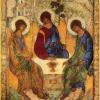Trinity Sunday
Trinity Sunday
“Holy, holy, holy; merciful and mighty!
God in three Persons, blessèd Trinity!”
– from the classic hymn

“Holy, holy, holy; merciful and mighty!
God in three Persons, blessèd Trinity!”
– from the classic hymn
In the liturgical year, the first Sunday after the Day of Pentecost is traditionally devoted to a celebration of the mystery, power, beauty, and community of the triune God. On this day, Trinity Sunday, the focus of the Church is on the Person and work of each member of the Trinity—Father, Son, and Holy Spirit—and on the theological truth that all three Persons exist together throughout all eternity, from all ages past, in the present now, and into eternity future.
Trinity Sunday marks the beginning of a new season of the Christian year—the longest season, and the final one. It is a very appropriate and powerful reorienting of worship and liturgy within the Christian year. After the drama and pageantry of the church year to this point—the expectant waiting of Advent, the joyful fulfillment of Christmastide, the illumination of Epiphany, the journeying with Christ during Lent, and the triumph of the Resurrection and Eastertide—we settle into an extended period of study and reflection on the ways in which our faith is worked out in our individual lives and together in community. But before we do, there are three Sundays which draw our attention to three of the most foundational and mysterious tenets of the Christian faith. The penultimate Sunday of Eastertide is Ascension Sunday, when we commemorate the moment when Christ, having completed His saving work on earth, ascended in bodily form into heaven, where He now sits at the right hand of the Father and where He now reigns as Christus Victor. On the final Sunday of Eastertide, Pentecost Sunday, which is fifty days after Christ’s resurrection from the dead, we commemorate the coming of the Holy Spirit upon the gathered disciples in the Upper Room and what is often referred to as the birthday of the Church. And on Trinity Sunday, we contemplate the nature of the triune God so that we may better understand, and experience, our relationship with Him and with each other within the community of the Father, Son, and Holy Spirit.
(If you are reading this post in the early weeks of the Season after Pentecost, you can find a sample liturgy in the Liturgy Folio.)
In the very early church, no one specific office or day was devoted to a focus on the Trinity. But by the fourth century, there arose a dispute that raged for over fifty years concerning the question of the nature of the Godhead and, initially and specifically, the nature and divinity of Christ. Interest in the issue was so widespread, wrote one Church Father, Gregory of Nyssa, that the question was debated not only among church leaders, but also in the marketplace, in the fields, and even between family members in their homes. The dispute, known as the Arian Controversy, erupted in the early years of the century between two theologians of Alexandria, Egypt: Arius, a Libyan elder and ascetic; and Athanasius, the bishop there. According to Arius’s reasoning, “If the Father begat the Son, he that was begotten had a beginning of existence: and from this it is evident that there was a time when the Son was not. It therefore necessarily follows, that he had his substance from nothing.” The problem, simply stated, was this: is Christ truly God, or merely a created (though exalted and powerful) being? In response, Athanasius appealed to the Scriptural underpinnings of “the eternal reality of God as Father,” famously arguing that if there ever was a time when the Son was not, then there was a time when the Father was not a father. Thus, by necessity, the Son was likewise equally eternal. Athanasius suggested the term homoousios to describe and explain the “consubstantial” nature of the Father and the Son. The Greek word means of the same being or essence.
These are the terms we find in the Trinitarian statement of faith, the Nicene Creed. The first Council of Nicea was convened by the Emperor Constantine in 325 to address the Arian Controversy. The resultant document, “the First Nicene Creed,” affirmed and proclaimed as doctrine the essential, eternal divinity of Christ. But nothing was said of the third Person of the Trinity beyond “and [we believe] in the Holy Ghost,” and further debates persisted about the nature and continuing work of the Son. Several decades later, a second ecumenical council was convened to settle these doctrinal issues. The original creed was amended by the First Council of Constantinople in 381 to address any remaining ambiguities concerning Christ, and to include additions and clarifications about the divinity and work of the Holy Spirit. This is the profession we now know as the Nicene Creed, and which declares the essential tenets of the doctrine of the Trinity.
By the sixth century, specific liturgies with canticles, responses, prayers, and hymns were being written, composed, and said at various times during the year, but the timing was inconsistent throughout Christendom. It's said that Thomas Becket, the 12th century Archibishop of Canterbury, declared the first Sunday after Pentecost as the festival day in honor of the Holy Trinity. By the early 14th century, this celebration was standard throughout Christendom.
We believe in one God, the Father almighty,
maker of heaven and earth,
of all things visible and invisible.
And in one Lord Jesus Christ, the only Son of God,
begotten from the Father before all ages,
God from God, Light from Light, true God from true God,
begotten, not made; of the same essence as the Father.
Through Him all things were made.
For us and for our salvation He came down from heaven;
He became incarnate by the Holy Spirit and the virgin Mary,
and was made human.
He was crucified for us under Pontius Pilate;
He suffered and was buried.
The third day He rose again, according to the Scriptures.
He ascended to heaven
and is seated at the right hand of the Father.
He will come again with glory
to judge the living and the dead.
His kingdom will never end.
And we believe in the Holy Spirit, the Lord,
the giver of life.
He proceeds from the Father, and with the Father and the Son
is worshiped and glorified. He spoke through the prophets.
We believe in one holy catholic and apostolic church.
We affirm one baptism for the forgiveness of sins.
We look forward to the resurrection of the dead,
and to life in the world to come.
Amen.
– Nicene Creed
Image credit: Rublev, Holy Trinity (c. 1430).
Copyright ©2021 Ellen Koehler. All Rights Reserved.


Login or Register
to view and post comments